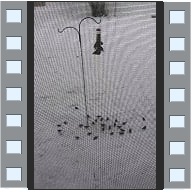In this issue:

A BEAUTIFUL GIFT
Recently we were presented with the wonderful gift of a stained glass window by one of our congregation members. The window consists of a lovely array of Buddhist symbols. The composite design was taken from a brooch designed by Rev. Master Jiyu called "The Symbolic Body of the Buddha" and represents the way in which training and enlightenment manifest within and through the body. The window is now mounted in the office door of our temple and beautifies its Dharma Room.
SYMBOLS OF THE BODY’S SPIRITUAL NATURE
The design features not only three easily recognizable Buddhist symbols—the lotus flower, the fish, and the knot of eternity—but also the conch shell, the jade center, and the blue background. Our body has both physical and spiritual aspects. These physical and spiritual aspects of our being work together as an organic whole, just as the organs do in the physical body. This is why physical practices, such as sitting straight in meditation and bowing, have such deep spiritual meaning and impact. The body of a Buddha is a body in which the spiritual aspects function in unhindered harmony with the Buddha Nature.
THE LOTUS FLOWER
The lotus flower is by far the most familiar symbol in the above picture. It represents the coming to full fruition of our inherent potential for Buddhahood—our inborn ability to live in harmony with our Truest Self, the Buddha Nature.
In order for a lotus plant to develop from a seed into a mature plant, it must stay rooted in the mud at the bottom of the pond. Only thus can it grow up through dark and murky waters toward the light of the sun. Likewise, our potential for enlightenment cannot be realized unless our spiritual life remains grounded within the “mud” of daily life with all its suffering and confusion. Because of this very suffering and confusion, we seek a way to spiritually grow through the murky waters of the world toward the light of the Eternal.
The lotus plant must develop a strong, robust stem in order to reach the surface of the pond. Our efforts to be true to the True Spirit of the Precepts and develop deep faith enable our Buddhist training to become the robust stem of our spiritual lotus plant.
The bud of the lotus plant one day rises above water and, orienting itself toward the sun, opens into a beautiful, immaculate flower. Even so does the bud of our innate potential for Buddhahood, which has its origin in our Buddha Nature, gradually rise above the water of worldliness and, orienting itself toward the Eternal, open into the flower of enlightenment.
Note that while drinking in the golden radiance of the sun, the lotus remains firmly rooted in the mud of the world. And from its flower develop seeds, some of which will survive and themselves grow into beautiful flowering lotus plants. Similarly, our spiritual training takes the seeming opposites of worldly life (the “mud”) and enlightenment (the “flower”) and fuses both into seeds of the Dharma which are scattered all around for the benefit of all sentient beings.
Because of its beauty, we tend to regard the flower as the most important part of the lotus. However, as Rev Master Jiyu relates in "How to Grow a Lotus Blossom," in our spiritual life, we must keep our focus on the “stem,” which is our spiritual training, rather than the “flower,” which is enlightenment. For just as the stem of the lotus enables the lotus plant to grow up from the mud and eventually flower, so our training makes it possible for enlightenment to manifest out of the mud of human suffering and confusion.
In the symbolic representation of the body, the lotus flower is at the top of the array of symbols. This position corresponds to the position of the head on the body. This symbolizes the awakening of our mind to the highest Truth. It is also helpful to think of the flower as rising above the head since this spiritual awakening transcends the confinement of understanding things just with our head.
To be continued...
NEWS OF THE TEMPLES
North Star Dharma Refuge
The infamous “Polar Vortex” blasted through the Upper Midwest in early February, leaving record low temperatures in its wake. The coldest day found the temple facing an overnight low of -31F (-35C), and a daily high of -18F (-28C). While Tom the temple cat parked himself on top of the meditation hall radiator, Rev. Bennet resorted to extra layers to see him through.
There’s a long tradition in Buddhist countries of buying animals in the market that are destined for slaughter and allowing them to live out their precious lives. In keeping with the spirit of this tradition, Rev. Bennet feeds the local birds and squirrels to help them survive the winter when food is scarce. During the week of the Polar Vortex the squirrels ate a dozen ears of corn and the birds 8 pounds of birdseed, as the following short video demonstrates taken through the screen of the common room window.

